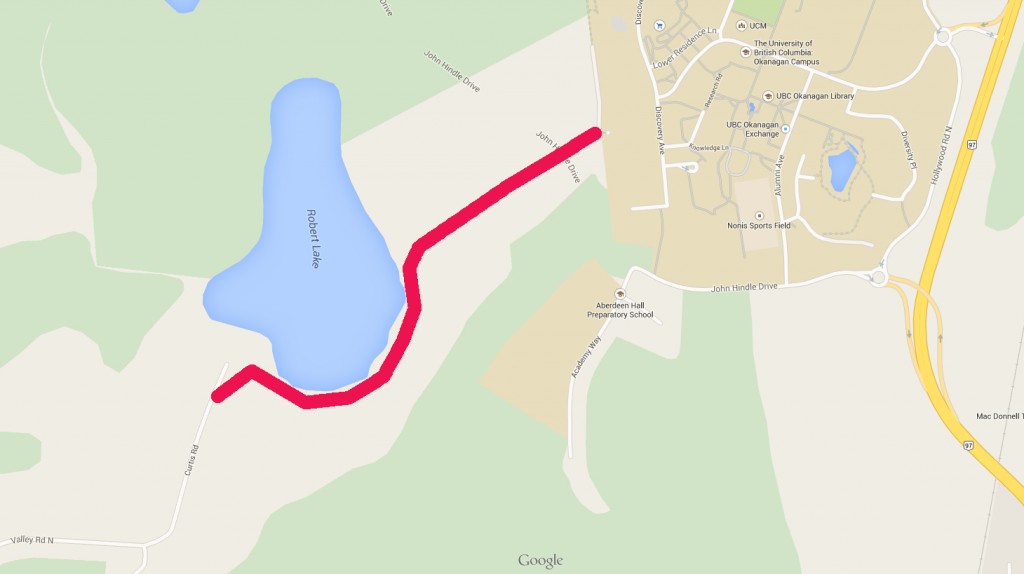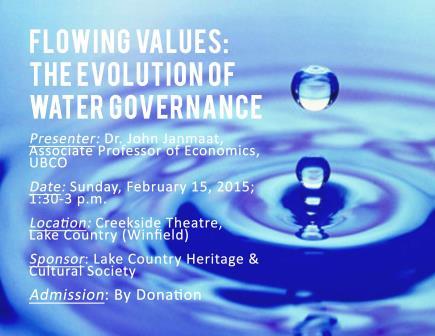There was one safe, convenient way to access the UBC Okanagan campus by bicycle from Kelowna. As of today, February 16th, 2015, for most of us, there isn’t. That route was along the private easement from the end of Curtis Road, along Robert Lake, to the west side of campus.
The issue of the rights to use the easement has been around since the campus was first created as part of Okanagan College. A Google search can turn up many stories documenting the ongoing conflict between some of the residents along Curtis Road and UBC. While there are many versions of the story, the core seems to be that the north campus of Okanagan College was created by combining a number of parcels of land, one of which had rights to use an easement that lead to the end of Curtis Road. At the time, this parcel seems to have been a hay field, so that access was only needed from time to time, at most daily in the summer for irrigation. The traffic currently using the easement to access UBC – a substantial number of cyclists, some pedestrians – some of whom are dropped off at the start of the easement – and a few people who drive to the end of the easement and drop someone off – is far more than was ever envisioned for the easement.
An easement is an interesting arrangement. In the case of Curtis Road, the easement provides each property owner with the right to cross the private property of her neighbours to access her land. This extends to visitors as well. When this agreement was made between the property owners, nobody envisioned an institution would arrive, and that that institution would result in a large increase in passage. The protracted legal battle between some of the residents and UBC Okanagan seems to have finally clarified what rights UBC has, and that is passage by people traveling for work to those buildings built on the original parcel. They cannot use the easement on days when they don’t have business in those buildings, nobody else accessing UBC can use it, and UBC must have an effective system in place to ensure that only those entitled to use the easement do.
This dispute highlights the challenge of balancing private property rights with the public interest. Clear and secure private property rights are foundational to a smoothly functioning economy and liberal-democratic society. The owners along Curtis Road have a clear and well defined set of rights in relation to their private property, and their rights to use the easement. The court has effectively ensured that these rights are secure and can be enforced. This is precisely what our system of legal rights and the institutions meant to support them are supposed to do. However, this also means that people who choose – or have no choice – to cycle to campus now must take a longer and in some parts much more dangerous route to campus. Has the enforcement of private property rights supported the public interest?
Economists as a rule see clear property rights and smoothly functioning markets as the best way to serve the public interest. The expression of this idea dates back at least to Adam Smith (The Theory Of Moral Sentiments, Part IV, Chapter I, pp.184-5, para. 10.)
Every individual… neither intends to promote the public interest, nor knows how much he is promoting it… he intends only his own security; and by directing that industry in such a manner as its produce may be of the greatest value, he intends only his own gain, and he is in this, as in many other cases, led by an invisible hand to promote an end which was no part of his intention.
Our profession is loath to suggest interfering with the market unless there is strong evidence to indicate that property rights and a freely functioning market are not serving the public interest. Rather, we would typically look for opportunities where small tweaks or ‘entrepreneurial’ solutions could be found that both satisfy the public interest and protect private rights. Are there any such solutions for this problem?
One simple solution would be for the residents to charge a fee for using the easement. Maybe $25 per month and $200 for the year. The cheapest two semester parking pass at UBCO costs $252, and the cheapest annual pass is $378. For a faculty or staff member, it may be worth spending $200 for such access. And if 50 faculty and staff people do so, then the residents have $10,000 per year to decide what to do with. Sounds simple and rational. Is it likely?
Feelings have been hurt. Some of the residents feel that their rights have not been respected, and that they have been bullied by UBC and ridiculed by self-righteous UBC staff and students. For some, their share of this $10,000 may not be enough to make up for this history of hurt, or they may simply value their privacy more than their share of $10,000. Adam Smith’s simple selfishly rational individuals may not adequately describe this situation, and a simple negotiated solution that permits access may not be possible.
Does this have anything to do with water, the usual subject of this blog? The dilemma of the right mix of private property rights and free choice by individuals against collective control in the public interest is huge in water. Economists – and I’ve been one of these at times – typically lament the lack of markets for water rights and the lost opportunities for more efficient water use as a result. Many others insist that water must remain in the public realm. Fundamentally, it is necessary for our survival and instrumental to environmental health, and opponents of markets for water rights feel something this important can’t be left to the whims of private owners.
As with so many societal choices, we need to reconcile multiple, conflicting values. Hard choices are hard because there is no obvious right answer (great TED talk here). We want to be part of a society that promotes active, healthy, safe and sustainable transportation options. We also want to be part of a society that respects our individual freedom to make choices and to do with our property as we wish. Here is a case where promoting one conflicts with the other. The courts have clarified the legal situation. The morally right choice though is far less obvious.


 Follow
Follow
